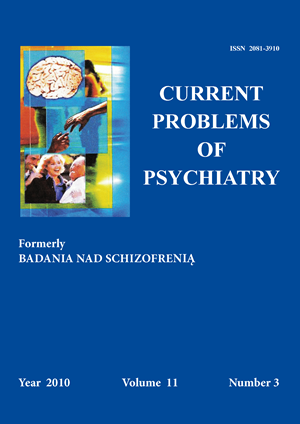Composition in schizophrenic artistic expression
Keywords:
composition, artistic expressionAbstract
The issue of composition in the artistic creativity of people suffering from schizophrenia has not been widely taken up by the researchers dealing with schizophrenic artistic expression. Those who wrote about the problems of composition mostly referred to familiar authors with schizophrenic disorders in the context of the course of their disease. However till now there has lacked a wider view on the composition’s specificity of those people’s artistic works. The article aims to approach the issue of expression’s psychopathology specifically dealing with the analysis of one element of the artistic work. Schizophrenic disorders provoke troubles with process of the arrangement, selection and information integration characteristic to specific thinking disorders of the delusional type. It is particularly visible in the composition of drawings and paintings.
Most often one can encounter compositional presentations that have an open configuration based on symmetry which is predominantly figurative in nature, with ornamentation and decorative background. In the literature on that subject there appear drawings by Edmund Monsiel (found in Kępiński’s book on schizophrenia), which mostly present multiple heads of different sizes, with characteristic moustaches, eyes and background abounding in rich ornamentation. In the literature available in the Faculty and Clinic of Psychiatry at the Medical Academy in Lublin and Neuropsychiatric Hospital in Lublin there also prevail open figurative compositions based on symmetry with richer or poorer ornamentation, visible in works of Maria Wnęk, Edward Grodek or anonymous authors. Chiaroscuro is a rarity, although Janusz Sokołowski is an exeption as he paid a lot of attention to that artistic element. His artistic compositions, which are rich in symbols and contain artistic depth, were created by putting several layers of paint on the canvas. The issue of the composition’s specificity in schizophrenic artistic expression is hard to judge objectively as most of the available works are shallow, schematic, open and without any depth or chiaroscuro. More interesting works, rich in elements typical of professionals, are rare. These are works of people with artistic education, who went down with an illness after they had gained artistic maturity. Disorders in portraying spatial relations look different in the works of educated painters and in the works of amateurs. Difficulties in analyzing the compositional rules that are prevalent among people with those disorders are connected with the lack of objective methods, which could be helpful in working on that artistic material.
References
1. Prinzhorn H. Artistry of the Mentally Ill. Wien New York; Springer-Verlag.
2. Wielka Encyklopedia Powszechna. Warszawa; PWN: 1969.
3. Madejska N. Malarstwo i schizofrenia. Kraków; Wydawnictwo Literackie: 1975.
4. Kępiński A. Schizofrenia. Warszawa; PZWL: 1972.
5. Welcz H. Symbolika w malarstwie chorych na schizofrenię. O twórczości plastycznej Janusza Sokołowskiego. Pamiętnik V LSN, Lublin;1996.


